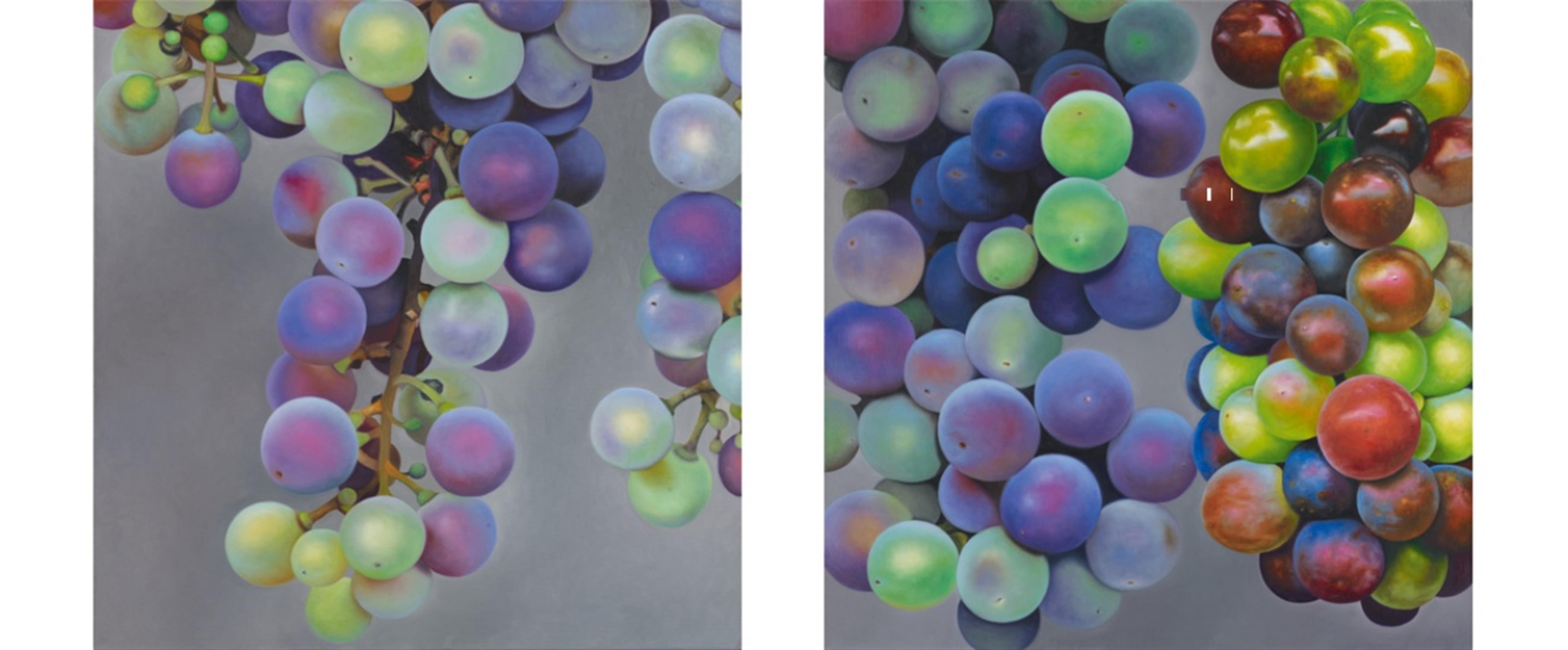Karin Kneffel
Untitled (Trauben)
2002
2-piece work: Oil on canvas. Each 100 x 100 cm. Verso on canvas each signed and dated 'Karin Kneffel 2002'.
Classical picture themes, tried and tested over the centuries, create the starting point for Karin Kneffel's painting. Animal pictures, interiors and fruit still lifes are genres she takes, expanding the pre-conditioned rules and creating something which is equally as traditional as it is irritatingly strange.
Fruit still lifes began to feature in her work from the mid-1990s. Cherries, peaches, plums and in particular grapes are motifs she uses in many variations, but always in extreme close-up and hyper-realistic perfection. All traces of the painting process have been extinguished from the smooth surfaces, unlike the depictions of domestic livestock, which came before, where the artist used the brushstrokes in the naturalistic depiction of fur, feathers and bristles.
Set before an anonymous grey background, the pendulous grapes are cut as if they were stage set pieces of a new composition. The focus seems so tight and oversized that the viewer finds himself so to speak amidst the fruit. The grapes appear to hang in slightly staggered picture layers: to the back the fruits are depicted in iridescent, pearl-like nuances, whilst in the foreground the grapes radiate a feeling of plasticity and materiality, their semi-translucent, shiny skin a promise of the juicy flesh beneath. Every single grape is perfectly round, almost hanging weightless and unimpaired by marks or tarnishes. However, this unnatural beauty, reminiscent of advertising motifs, still leaves an unseen, insurmountable barrier between the work and the viewer. One Kneffel exhibition in 2006 (in Ulm, Bad Homburg and Goslar), had the appropriate title of 'Verführung und Distanz' (Seduction and Distance). This could be applied programmatically to her still lifes. For although it is difficult to see past the monumental presence and finished materiality, they cannot be confused with nature. 'The artificial and nevertheless sensuous silkiness of the picture entices and distances at the same time; in this way it can be compared to high gloss advertising photographs. The concentration on the intact and therefore self-contained form also implies abstraction', writes Brigitte Reinhardt (in: Karin Kneffel, exhib.cat. Galerie Ludorff, Düsseldorf 2010, p. 2).
Karin Kneffel's fruit pictures differ considerably from the fruit and food still lifes of the Baroque, which to a certain extent contested with nature in their deceptive representation of fine luxury goods. They intended to present the charms of the earthly treasures in such a seductive manner that the viewer believed they could capture them with all their senses. At the same time, each small blemish and trace of withering and decomposition instead enhanced the impermanence and transience of their glory in the viewer's memory. In comparison however, the fruits depicted by Karin Kneffel did not have the intention of creating a trompe-l'oeil-effect, or anything other than appealing to the viewer's visual sense. Kneffel's fruit pictures also do not inhabit any admonishing vanitas motif. They do not depict real life and do not tell a story. As cool allegories they represent an unattainable and therefore almost threatening ideal. Condensed entirely down to their illustrative characters, one could say their frozen perfection is conserved within the canvas square.
Provenance
Christine König Galerie, Vienna (with label verso); private collection, North Rhine-Westphalia
Exhibitions
Vienna 2002 (Christine König Galerie), Früchte und Ornamente, Neue Malerei

